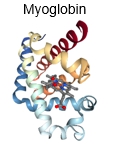So now that we've covered the Anfinsen experiment, in this video, we're going to talk about protein folding. Protein folding has many different contributing factors, but it heavily relies on noncovalent interactions such as the hydrophobic effect, which we can see in our example of protein folding below. Recall from our previous lesson on the Anfinsen experiment that the final protein conformation ultimately depends on the primary level of protein structure and the final protein conformation. Typically, protein folding leads to nonpolar hydrophobic amino acids being found on the interior of the protein, and polar hydrophilic amino acids on the perimeter. We see this in our example below.
On the left over here, we have an unfolded polypeptide chain. The black line represents the peptide backbone. Each of these red balls represents hydrophobic amino acid residues that are nonpolar. On the other hand, the blue balls represent hydrophilic amino acid residues that are polar. This is our unfolded polypeptide chain. But after it undergoes protein folding, the tendency is for the nonpolar hydrophobic amino acid residues in red to be tucked away into the interior because they are water-fearing. The clumping of these hydrophobic amino acid residues is initiated by the hydrophobic effect. The hydrophilic polar amino acid residues, which want to interact with the aqueous water environment surrounding the protein, are likely to be found on the perimeter of the protein.
In our image on the right, we show the 20 amino acids and where we are likely to find these proteins after protein folding, in terms of being on the inside or the outside of the protein. Within our neutral amino acid residues, we've divided them into nonpolar and polar amino acid groups. We don't have our aromatic amino acid group because we've distributed the aromatic amino acids—phenylalanine, tyrosine, and tryptophan—amongst the nonpolar and polar groups. For our nonpolar amino acids, our mnemonic is GAV LIMP. Adding tryptophan and phenylalanine, we can remember this by saying that our buddy Gavin, who is limping away on crutches from the water fast, forms the mnemonic GAV LIMP way fast. These nonpolar amino acids are hydrophobic and will be tucked into the interior of the protein, as we see with these red hydrophobic residues.
To the opposite extreme, we have amino acids with full charges at physiological pH. The mnemonic to remember these is "dragons eat knights riding horses." We have negatively and positively charged amino acids that are very hydrophilic or very water-loving. They interact with the water molecules surrounding them thus, they are found on the perimeter of the protein. In the middle, we have polar amino acids. They are neutral at physiological pH but are still polar, though not as much as the charged ones. As they are somewhat hydrophilic, they can be found either on the inside or the outside of the protein, which means they are distributed throughout the protein. The mnemonic for the polar amino acids is "Santa's team crafts new quilts," and the "y" for Tyrosine can be added to this mnemonic.
This concludes our lesson on protein folding and how the amino acids are distributed throughout a protein. We'll be able to practice these concepts in our next practice video. I'll see you guys there.



